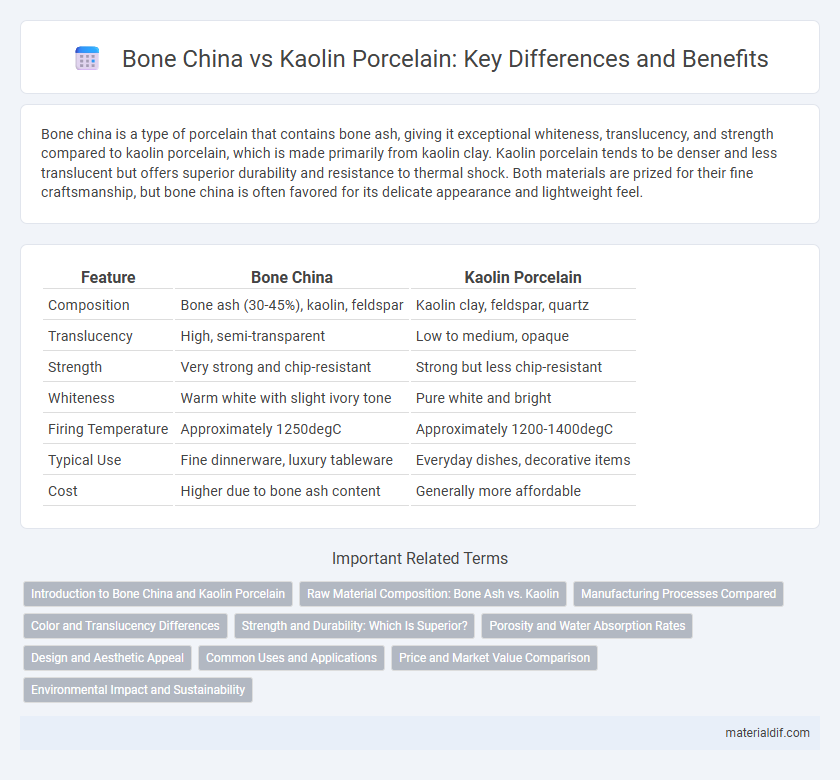Bone china is a type of porcelain that contains bone ash, giving it exceptional whiteness, translucency, and strength compared to kaolin porcelain, which is made primarily from kaolin clay. Kaolin porcelain tends to be denser and less translucent but offers superior durability and resistance to thermal shock. Both materials are prized for their fine craftsmanship, but bone china is often favored for its delicate appearance and lightweight feel.
Table of Comparison
| Feature | Bone China | Kaolin Porcelain |
|---|---|---|
| Composition | Bone ash (30-45%), kaolin, feldspar | Kaolin clay, feldspar, quartz |
| Translucency | High, semi-transparent | Low to medium, opaque |
| Strength | Very strong and chip-resistant | Strong but less chip-resistant |
| Whiteness | Warm white with slight ivory tone | Pure white and bright |
| Firing Temperature | Approximately 1250degC | Approximately 1200-1400degC |
| Typical Use | Fine dinnerware, luxury tableware | Everyday dishes, decorative items |
| Cost | Higher due to bone ash content | Generally more affordable |
Introduction to Bone China and Kaolin Porcelain
Bone china is a type of porcelain known for its high whiteness, translucency, and strength, created by combining bone ash, feldspar, and kaolin clay. Kaolin porcelain, often called hard-paste porcelain, primarily utilizes kaolin clay and petuntse, resulting in a dense, durable ceramic with a matte finish. Both materials are valued in fine tableware, with bone china offering superior translucency and kaolin porcelain prized for its robustness and heat resistance.
Raw Material Composition: Bone Ash vs. Kaolin
Bone china is characterized by its distinct raw material composition, primarily incorporating bone ash derived from calcined animal bones, which contributes to its high whiteness, translucency, and strength. In contrast, kaolin porcelain relies on kaolin clay, a naturally occurring mineral rich in alumino-silicates, providing rigidity and a smooth, dense structure but usually lacking the translucency found in bone china. The presence of bone ash in bone china significantly enhances its mechanical properties and aesthetic appeal, differentiating it from traditional kaolin-based porcelain.
Manufacturing Processes Compared
Bone china is crafted by adding bone ash to the clay mixture, creating a translucent, lightweight material through a higher firing temperature between 1200degC and 1250degC. Kaolin porcelain relies primarily on kaolin clay, feldspar, and quartz, fired at temperatures around 1300degC, resulting in a denser and more vitrified body. The distinct mineral compositions and firing regimes produce bone china with exceptional whiteness and translucency, while kaolin porcelain achieves greater strength and a less porous structure.
Color and Translucency Differences
Bone china exhibits a warm, ivory hue with exceptional translucency due to its high bone ash content, making it more delicate and light-permeable compared to kaolin porcelain. Kaolin porcelain typically has a whiter, more opaque appearance with lower translucency, as its composition is dominated by kaolin clay, which offers greater strength but less light transmission. These differences in color and translucency significantly influence their aesthetic appeal and suitable applications in fine dinnerware and decorative items.
Strength and Durability: Which Is Superior?
Bone china exhibits superior strength and durability compared to kaolin porcelain due to its high bone ash content, which enhances its mechanical toughness and chip resistance. Kaolin porcelain, made primarily from kaolin clay, is harder and more brittle, making it more prone to cracking under stress. The combination of bone ash, feldspar, and kaolin in bone china results in a lightweight yet robust material ideal for everyday use and fine tableware.
Porosity and Water Absorption Rates
Bone china exhibits lower porosity and water absorption rates compared to kaolin porcelain, resulting in a more durable and less porous material. Kaolin porcelain typically has higher porosity due to its mineral composition, which leads to increased water absorption. The reduced porosity in bone china enhances its strength and resistance to staining, making it ideal for fine tableware.
Design and Aesthetic Appeal
Bone china exhibits a translucent, delicate appearance with a smooth, ivory-white finish that enhances intricate design details, making it a popular choice for fine tableware and decorative pieces. Kaolin porcelain offers a slightly more opaque and robust texture, with a pure white color that provides a clean canvas for vibrant glazes and bold patterns. Both materials hold distinct aesthetic appeals, with bone china favoring elegance and translucency while kaolin porcelain emphasizes durability and vivid design expression.
Common Uses and Applications
Bone china is highly valued for its translucency and strength, making it ideal for fine diningware, decorative items, and luxury table settings. Kaolin porcelain, known for its durability and high resistance to thermal shock, is commonly used in industrial applications, laboratory equipment, and practical dinnerware. Both materials serve distinct purposes, with bone china favored in elegant presentations and kaolin porcelain preferred for functional and heavy-use items.
Price and Market Value Comparison
Bone china commands higher prices in the market due to its translucency, strength, and higher bone ash content, making it a luxury choice among porcelain types. Kaolin porcelain, primarily composed of kaolin clay, is more affordable and widely produced, appealing to budget-conscious consumers and everyday use. Market value of bone china remains elevated in premium dinnerware segments, whereas kaolin porcelain holds a stable position in mass-market ceramics.
Environmental Impact and Sustainability
Bone china, primarily composed of bone ash, offers high strength and translucency but raises concerns due to ethical issues surrounding animal byproducts and higher energy demands in its production. Kaolin porcelain, made mainly from natural clay minerals, generally has a lower environmental footprint, benefiting from abundant raw materials and more eco-friendly firing processes. Sustainable practices in kaolin porcelain manufacturing also include utilization of recycled materials and reduced greenhouse gas emissions, making it a greener alternative compared to traditional bone china.
Bone china vs Kaolin porcelain Infographic

 materialdif.com
materialdif.com